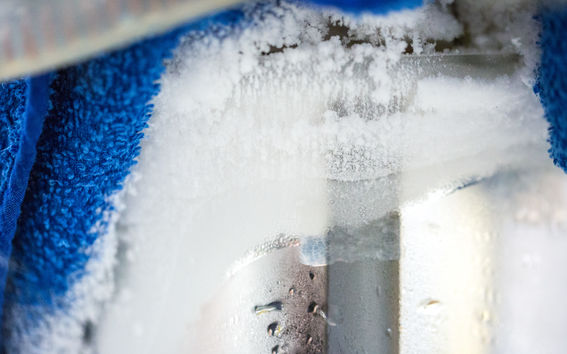Record low temperatures

Low Temperature Laboratory has produced several world records of low temperatures in about thirty years' span and still holds the record for macroscopic condensed matter systems. We reached nano- and picokelvin range temperatures by cooling nuclear spin systems in different metals (Cu, Ag, Rh) - see the figure above. Our latest effort produced 100 pK for the nuclear spin system of rhodium metal. Recently, however, atomic spins in ultracold magneto-optically trapped atom ensembles have been cooled to similar range of temperatures.
World record in low temperatures
The record-low temperature was produced in about two-gram piece of rhodium metal, which was cooled to 100 pK, or 0.000 000 000 1 degrees above the absolute zero. The absolute zero is the limit of all temperatures, -273.15 degrees celsius, a temperature one can never reach. However, at the Low Temperature Laboratory, the researchers have for more than 20 years been reaching closer and closer. The former Low Temperature World Record of 280 pK was also set here in 1993.
These results were for almost 9 years in preparation. Many scientists have contributed to the project, most recently the team was: T.A. Knuuttila, J.T. Tuoriniemi, K.I. Juntunen, and K.K. Nummila from the Low Temperature Laboratory, and two Danish researchers: K. Lefmann (Risø National Laboratory), and F.B. Rasmussen (University of Copenhagen).
This long lasting effort was not made with the sole purpose of achieving ever lower temperatures. The main objective was to study the magnetism of the atomic nuclei of the rhodium metal. Each of the billions of nuclei in rhodium has very small magnetic moment like a small compass needle. By lowering the temperature the researchers expected the moments to "freeze" as known from e.g. household magnets, and also seen in similar ultra-cold experiments with copper, silver, and lithium, for example. Unexpectedly, the rhodium nuclear moments did not freeze even at this record-low temperature, although the system showed clear tendency to collective behavior. The study of such magnetic response is related to a much wider scope of physical phenomena, e.g. the study of high-temperature superconductivity.
Superconductivity at extremely low temperatures
As an additional feature, rhodium metal also becomes superconducting with very low transition temperature, comparable with only lithium among all the elements. The researchers were able to study how nuclear magnetism affects the superconducting electrons. This study was very successful and created several interesting results.
Negative absolute temperatures
Yet another intriguing feature of the nuclear spin systems is that they can be "tricked" to negative absolute temperatures by suitable manipulation of the external magnetic field. In a sense, the spin system at negative temperature is hotter than at any positive temperature, since it holds more energy that at infinite temperature. The closer one approaches absolute zero from the negative side, the hotter the system gets. If one first prepares very cold spin system at the positive side of absolute zero, then flips it to the negative side, the result is an extremely hot system, which seeks towards thermal equilibrium by emitting energy to the surroundings. This has been demonstrated in several cases during our work on nuclear spin systems and, in fact, record "high" temperature of -750 pK has been produced in rhodium metal. It is important to note that the concept of negative absolute temperature does not violate the inaccessibility of absolute zero, since the positive and negative side are actually connected through infinite temperature, which is equal in both cases irrespective of the sign of temperature.
The apparatus reaching the record low (and high) temperatures consists of several consecutive cooling stages. The central parts of the cryostat are a dilution refrigerator reaching a temperature of 3 mK, and two nuclear cooling stages utilizing the method of adiabatic nuclear demagnetization. The first nuclear stage cools to a temperature of about 50 µK, whereas the second nuclear stage, the sample itself, reaches the record low temperatures in the picokelvin-regime.
* The experimental methods and results are presented in detail in T. Knuuttila’s Ph.D. thesis.
* The follow-up experiments on lithium are discussed in K. Juntunen's Ph.D. thesis, while the discovery of superconductivity in lithium was published in Nature.
* Schematic diagram of the cryostat in a PDF file (ltl.tkk.fi)
* More information about the microkelvin research group






